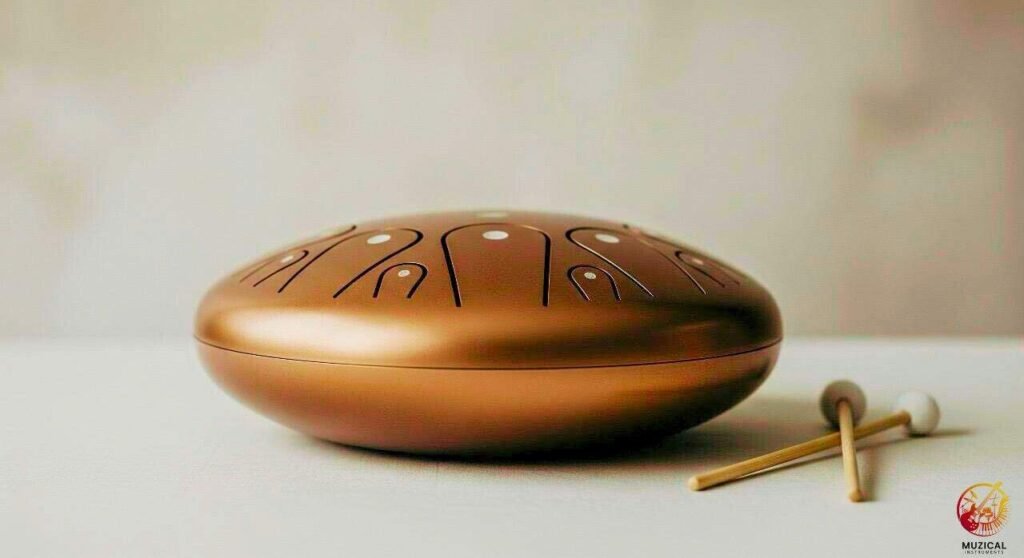Steel Tongue Drum Sound Therapy for Beginners: A Grounding Start to Healing Through Vibration
When you strike a steel tongue drum, you don’t just hear sound, you feel its healing vibrations. More wellness centers, music therapists, and even trauma counselors are turning to this simple, hand-played stress relief instrument to help people heal.
Why? Because its vibrations work on both the body and the mind.
Steel tongue drum sound therapy offers a non-invasive, calming way to reduce anxiety, release emotional blockages, and improve focus. If you’re just starting your sound healing journey or want to add a gentle but powerful tool to your holistic healing practice, this guide walks you through everything you need to know.
You’ll learn how this instrument works, why it has become a go-to for many holistic health seekers, how it’s used in therapy sessions, and how you can start your own healing practice with it, even if you’ve never touched a drum before.
What is a Steel Tongue Drum, and Why Is It Used in Sound Therapy?
A steel tongue drum is a round, hollow metal instrument with laser-cut or hand-cut “tongues” on the top surface. When struck with mallets or fingers, these tongues produce soft, bell-like tones. Each tongue is tuned to a specific note, often forming a scale such as pentatonic, diatonic, or chromatic.

Sound therapists value steel tongue drums for their purity of tone and harmonic resonance, making them a cornerstone of auditory wellness. Unlike harsher-sounding instruments, these drums produce soothing, meditative sounds that require no musical skill to enjoy.
In therapy, the goal isn’t performance. It’s presence. You simply play, breathe, and listen. The frequencies produced can lower your brainwave activity, moving you into alpha or theta states. These brainwave states are associated with deep relaxation, emotional processing, and creative flow.
Real-World Use:
Holistic clinics use steel tongue drums in meditation and mindfulness classes, massage sessions, and trauma recovery programs. As one of many music therapy techniques, a therapist might strike specific notes for chakra balancing, creating a harmonized auditory field.
Expert Insight:
According to clinical sound therapist Julie Maren, “The steel tongue drum’s simplicity makes it accessible for clients who feel intimidated by traditional instruments. And because each note is harmonious, there’s no fear of playing it ‘wrong.'”
How Do Vibrations from a Steel Tongue Drum Affect the Body and Mind?
When you hear music, your brain and body respond. But when you feel the vibration from a steel tongue drum, it goes deeper. This is the core principle of vibrational medicine. The drum’s low frequencies can actually be felt in the body, especially when played close to the person or placed near the chest or abdomen.
Physiological Benefits:
- Slows heart rate and lowers blood pressure
- Reduces cortisol levels (the stress hormone)
- Encourages deep breathing
Mental Benefits:
- Improves mood
- Increases focus and attention span
- Supports emotional regulation
Emotional Impact:
Many beginners report a sense of emotional release after a 10-minute session with a steel tongue drum. Because the notes are tuned to resonate with the human energy field, they can help release stored tension in the body.
Case Study:
In a 2022 pilot study at a recovery center in Oregon, 12 participants with PTSD engaged in weekly steel tongue drum sessions. After six weeks, 83% reported reduced anxiety and improved sleep.
Pro Tip:
Play slower rhythms with intentional pauses. This helps your nervous system settle and shift out of “fight or flight.”
Can You Really Use a Steel Tongue Drum Sound Therapy Without Musical Training?
Absolutely. This is what makes the steel tongue drum such a beginner–friendly tool. You don’t need sheet music, finger dexterity, or years of practice. All the notes are in harmony, meaning no matter what combination you strike, it will sound good.

Getting Started:
- Choose a drum tuned to a pentatonic scale (easy to learn)
- Use your hands or soft mallets
- Play slowly, focusing on how each note feels
Activity Example for Meditation and Mindfulness:
Close your eyes. Strike one note gently and let the sound fade completely. Then play another. You’ll begin to notice how each note makes you feel. This simple practice builds meditation and mindfulness, along with emotional awareness.
Why This Matters:
When you remove the fear of “doing it wrong,” people feel more confident exploring. This is crucial in therapy settings, especially for clients dealing with anxiety or trauma. The drum becomes a safe space to express and explore.
Expert Insight:
Music educator Tara Lasky says, “I’ve worked with dozens of children who wouldn’t speak in sessions, but they would play. That’s where healing begins.”
What Are the Best Ways to Use Steel Tongue Drums in Daily Wellness Routines?
You don’t need to be in a therapy room to benefit. The steel tongue drum fits into home routines easily. Think of it like a toothbrush for your emotional hygiene.
Morning Routine:
- Start your day with 5 minutes of playing
- Focus on gratitude or set an intention with each note
During Work Breaks:
- Step away from the screen
- Play a short 3-note sequence to reset your focus
Evening Wind-Down:
- Pair your playing with deep breathing
- Let each note signal your body to relax
Sound Bath Therapy Example:
One of the most immersive music therapy techniques you can try is a sound bath. Lie on your back. Place the drum near your feet or chest. Ask a friend to play a slow rhythm. Let the healing vibrations flow through your body. This is a deeply grounding form of sound bath therapy.
Step-by-Step Table: How to Build a 10-Minute Drum Routine
| Time | Activity | Purpose |
|---|---|---|
| 0–2 min | Breathe deeply & stretch | Center yourself |
| 2–5 min | Play slow, repeating patterns | Create consistency & calm |
| 5–8 min | Improvise with eyes closed | Foster creativity & intuition |
| 8–10 min | Sit in silence after playing | Absorb the benefits |
Pro Tip:
Use a timer so you’re not watching the clock. Just feel the rhythm and let your nervous system recalibrate.
How Do You Choose the Right Steel Tongue Drum for Your Needs?
Not all steel tongue drums are created equal. Some are designed for musicians, others for healing. Beginners should choose a drum that feels right to them in tone, weight, and scale.
Consider These Factors:
- Scale Type: Pentatonic scales are forgiving and harmonious
- Size: Smaller drums (6-10 inches) are more portable but have less resonance
- Material: High-quality steel produces better tone and longer sustain
- Tuning: Consider drums tuned to 432Hz for a softer, healing tone
Comparison Table: Drum Types for Beginners
| Drum Size | Scale Type | Tuning | Best For |
|---|---|---|---|
| 6 inch | Pentatonic | 432Hz | Kids, travel, quick breaks |
| 10 inch | Diatonic | 440Hz | Home practice, beginners |
| 12+ inch | Chromatic | 432Hz | Sound baths, deeper tones |
Expert Insight:
Look for brands with clear note markings and soft mallets included. Reviews from therapists or yoga instructors can also be a helpful guide.
Final Thoughts: Is Steel Tongue Drum Sound Therapy Right for You?
If you’re looking for a gentle way to reduce stress, reconnect with yourself, and begin a holistic healing practice that doesn’t require musical talent, steel tongue drum sound therapy is worth exploring. As a powerful stress relief instrument, it offers an accessible path to auditory wellness.
You’ve learned what the instrument is, how it impacts your body and mind, and how to use it daily. Now it’s time to give it a try. Start with a simple scale, listen deeply, and trust your hands.
Your sound healing journey doesn’t need to be loud. Sometimes, one soft note at a time is all it takes.
Next Step: Find a beginner-friendly steel tongue drum, set aside ten quiet minutes a day, and let your healing begin.
If you’re new to sound healing, learn what a steel tongue drum is and how it works before you dive into your first session.
Frequently Asked Questions: Steel Tongue Drum Sound Therapy
Q1. How long should a beginner play the steel tongue drum each day?
Start with 5–10 minutes daily. Consistency matters more than duration. Even a short, mindful session can help reset your mood and focus.
Q2. Do I need headphones or speakers to feel the benefits?
No. In fact, playing the drum live enhances its vibration effect. However, recording your sessions and playing them back can be soothing for passive listening.
Q3. Can children use steel tongue drums for calming activities?
Yes, absolutely. The soft tones are gentle on young ears, and the intuitive design makes it fun for kids. It can be a great tool for emotional regulation.
Q4. What is the difference between 432Hz and 440Hz tuning?
432Hz is often called the “healing frequency” and is believed to resonate more naturally with the body. 440Hz is standard concert pitch. Both are valid 432Hz is simply gentler.
Q5. Can the steel tongue drum help with sleep?
Many users report better sleep after incorporating the drum into their nighttime routine. Try playing slow, repetitive patterns right before bed to cue your body to relax.
